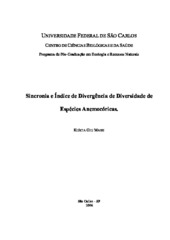Sincronia e índice de divergência de diversidade de espécies anemocóricas
Abstract
The Cerrado Domain is the second largest Brazilian phytogeographic province, occupying
originally 23% of Brazil s land surface, under seasonal climate. The cerrado presents a
floristic and physiognomic variation, ranging from grassland to tall woodland. Anemochorous
species are proportionally more important in the cerrado than in Brazilian rain forests,
especially in open physiognomies. Morphological designs of wind-dispersed diaspores appear
to slow their rates of descent, increasing their chances of exposure to winds and of reaching
safe sites to germinate. Wind-dispersed species are constrained to fruit during the best time
for seed dispersal. Also, the height of seed release and surrounding vegetation are
fundamental to long-distance dispersal. We selected the wind-dispersed species from three
phytosociological surveys (disjoint and core sites) and classified them into autogyro, rollingautogyro,
floater, or undulator, according to the diaspore morphology and aerodynamic
behavior in still air. For each species, we had data on its fruiting period. We tried to assess
whether there was a seasonality and, if there was, whether it was synchronized with some
climatic conditions. The number of fruiting anemochorous cerrado species was highest at the
dry season, coinciding with reduced precipitation. Next, we studied the anemochorous
diaspore spectra and index of divergence from species to anemochorous diaspore diversity
(IDD) in three cerrado physiognomies (campo cerrado, cerrado sensu stricto, and cerradão)
in a disjoint site and three cerrado physiognomies (cerrado sensu stricto) in different floristic
pronvinces. There was a floristic unit among the cerrado physiognomies, with the ecotonal
ones containing both grassland and woodland elements. Both nuclear and disjoint sites were
ecologically similar regarding the species distribution. However, there were differences when
species abundances were considered. In denser sites, vegetation reduces wind velocity in ...
